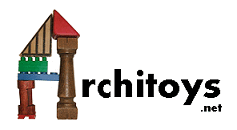
Whilst the simplest form of building toy is the stacking brick, these suffer the obvious drawback of easy accidental demolition. To get over this, and in some cases to permit building configurations that would not be possible with stacking bricks, an obvious solution is to find ways of interlocking the rows of bricks. Various linking methods have been tried, not always with complete success.
I am using the term interlocking here to mean a method of linking rows together, but this does not necessarily mean that the bricks "bind". Binding bricks are those that will not come apart even if turned upside down or knocked over but stay locked together until physically separated. Some are not intended to bind, whilst others which should, don't do so very successfully!
A well known british range is Betta Bilda which uses the same stud and socket arrangement as Lego but has a quite different approach to the roof. Rather than using bricks with an angled cut-away, these sets have overlapping tiles which link together by tiny studs and holes and rest on top of the walls. A wide variety of tile configurations allows pleasingly complicated roofs to be constructed. (I love interesting roofs - they are a rarely seen part of a building and hence rather mysterious)
Not all plastic bricks use the push-on stud and socket approach however. Airfix Building Set bricks have square studs on the top surface with recessed edges over which a cut-out in the lower face of the next brick slides over from the side. This set provides a cardboard sheet printed with a tile pattern from which one is supposed to cut roofs to fit ones buildings.
Minibrix windows and doors are thin transparent sheets with printed details which fit into the walls by means of tiny studs locating into small holes in the upper and lower surfaces of the bricks. Hinged green rubber roofs with moulded tile designs come in various sizes and there are two angles of gable brick. Bricks are plain rectangular shapes in dark red, but white beams with sockets on both faces are provided for the foundation row and as lintels over windows and doors. Little double-ended studs are used to fix these bricks in. White decorative balustrades and fluted column sections provide decorative relief from the otherwise rather bleak architectural style of the suggested models.
Black and white Tudor Minibrix sets were produced but seem to be rather hard to come by.
|
|
|
|
|
|
|
|
|